The eight secrets of fast bowling
Cricket may be seen as a slow and sedate game, but it has its fair share of dramatic moments – often thanks to the flair and power of its lightning-quick bowlers.
With the 2019 men’s Cricket World Cup now underway, Build Me a Fast Bowler explores how bio-mechanical experts are now able to analyse the complex movements that make up a bowler’s action to help cricketers and coaches maximise performance and reduce injuries.
-
![]()
Listen to Build Me a Fast Bowler
Jonathan Agnew unravels the qualities that make the perfect fast bowler.
Read on for eight things we’ve learned from the frontier of cricketing science...

1. Fast bowling isn’t all about muscle
Strength isn’t the limiting factor when it comes to bowling speed – it’s more about the physical action. Mark King, bio-mechanics expert at Loughborough University, says, “All else being equal, being a bit stronger will help, but it’s technique that’s more important.”
2. Virtual models are used to improve performance
Experts at Loughborough University have spent 15 years breaking down the mysterious set of movements that make up the bowling action. They can now create sophisticated personalised virtual models of bowlers’ actions and analyse them to work out how to improve every aspect.
England fast bowler Mark Wood says these adjustments make a big difference: “When everything clicks it just almost feels effortless, like you’re just bounding in and bowling as quick as you can with no other distractions... You feel free, almost like a superhero.”
3. The run-up is all-important
The steps taken before a ball is bowled may look like a precursor to the main action, but they’re crucial to generate energy and speed that will help propel the ball forward. The best fast bowlers run in at around 25 kilometres per hour (that's about 15 miles per hour in old money).
The best fast bowlers run in at around 25 kilometres per hour (about 15 miles per hour).
4. Elegance isn’t everything
Fast bowler James Anderson has taken over 500 test wickets – more than any bowler in history. But his career almost ended early – at 24 – when coaches tried to reshape his unconventional bowling action.
Cricket writer Emma John explains: “People like the elegant in cricket.” And Anderson’s style just wasn’t what they expected to see. “As he came and slung his arm over, his head would almost be pointing at the ground.”
But Anderson found it incredibly difficult to change the way he bowled. “The ball wasn’t going where I wanted it to,” he says. “I wasn’t bowling any quicker either. I had a stress fracture in my back… and then, eventually, I got dropped.”
Fortunately for Anderson – and England cricket – after two years, new coach Kevin Shine brought him back on board the England team and let him return to his old bowling style. He’s now been at the top of the game for almost two decades.

5. The aim is to reduce reaction time
The faster a ball is bowled the less time the batsman has to react, and even shaving off a tenth of a second can make a huge difference. Cricket coach Ian Pont says today’s best bowlers are pushing the limits of what batsmen can deal with, and at 95mph “you start to get to the top end in terms of human reaction time.”
James Anderson says a ball thrown at 90mph gives the batsman around 0.4 seconds to respond – that’s 20 percent less than a ball bowled just 10mph slower. In that brief space of time, “you’ve got to see the ball come out of the hand, you’ve got to see where it pitches, and you’ve got to make a decision of what you’re going to do with that ball.”
6. Small differences in flexibility can mean major gains
While the top female cricketers currently bowl slower than the leading men, bio-mechanical science is revealing ways in which they may have an edge. For example, some of the flexibility in women’s joints is different, which could enable more effective techniques.
The flexibility in women鈥檚 joints is different, which could enable more effective techniques.
Mark King explains: “If you do everything else the same but have an elbow that will hyper-extend, you can bowl four miles an hour quicker. You get a four-mile-an-hour advantage just by having that natural attribute.”
7. Better bio-mechanical science means fewer injuries
Fast bowlers have always been prone to injury because of the pressure the movements put on so many parts the body – especially the back. Nick Pearce, Chief Medical Officer for England and Wales says, “The adaptation required to be a fast bowler is greater on the spine than any other sport, just because it’s so hard on the bone.”
But now, sophisticated computer modelling is enabling scientists to identify when parts of a bowler’s physique are under particular strain so they can make changes before they get hurt. James Anderson explains that “we can calculate how quick we’re running across the ground, how much force we’re putting in through our body – that’s why you see fewer and fewer injuries.”
8. 100 is the magic number
Today’s fastest bowlers can hurl a ball at an astonishing 90 miles per hour. But the Holy Grail of fast bowling is the 100mph mark – which has only officially been broken once. In 2003, Pakistan’s superstar bowler Shoaib Akhtar entered cricket’s history books at the Men’s Cricket World Cup in South Africa, and his record remains unbeaten 16 years later.
More cricket from Radio 4
-
![]()
Build Me a Fast Bowler
Jonathan Agnew unravels the qualities that make the perfect fast bowler.
-
![]()
Desert Island Discs: Castaway Cricketers
Listen to cricketing legends reveal their Desert Island Discs.
-
![]()
Don't Tell Me The Score: Mike Brearley
Simon sits down with the legendary England cricket captain turned top psychoanalyst Mike Brearley.
-
![]()
11 things you didn't know about W.G. Grace
Cricketer W.G. Grace is still one of the most famous names in sport




